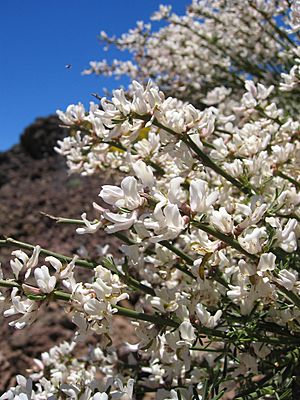White-flowered broom facts for kids
Quick facts for kids White-flowered broom |
|
|---|---|
 |
|
| Cytisus supranubius growing high up on Roque de los Muchachos, La Palma, Canary Islands, Spain | |
| Scientific classification | |
| Synonyms | |
|
Cytisus supranubius is a special plant known by a few names, like white-flowered broom or retama del Teide. It is a type of broom plant. This plant is unique because it only grows in the Canary Islands, which means it is an endemic species.
You can find this plant growing very high up, usually around 2,000 meters (about 6,500 feet) above sea level. It lives on the island of Tenerife in a place called Las Cañadas del Teide. It also grows on the mountain tops of La Palma.
What's in a Name?
The scientific name "supranubius" is made of two Latin words. "Supra" means "above," and "nubius" means "clouds." So, "supranubius" means "above the clouds."
This name is perfect for the plant! It refers to how high up this plant grows on the islands of Tenerife and La Palma. It often grows above the level where clouds usually form, which people sometimes call the "sea of clouds."
Where it Grows
The Canary Islands are a group of islands in the Atlantic Ocean. They are known for their unique plants and animals. Cytisus supranubius is one of these special plants.
It thrives in the high, sunny, and often windy conditions of the mountains. The plant has adapted to these tough environments. It can handle the cold temperatures and strong sunlight found at high altitudes.
Appearance and Life
The white-flowered broom is a shrub, which is a woody plant smaller than a tree. It has many branches and beautiful white flowers. These flowers often bloom in spring and summer.
The plant plays an important role in its habitat. It helps prevent soil erosion on the steep mountain slopes. Its flowers also provide food for insects, like bees, which help pollinate other plants.
See also


